Buzzer in Chicago: Six hours, 10 trains, 11 trips—looping the loop in Chicago!
Buzzer in Chicago: Six hours, 10 trains, 11 trips—looping the loop in Chicago!
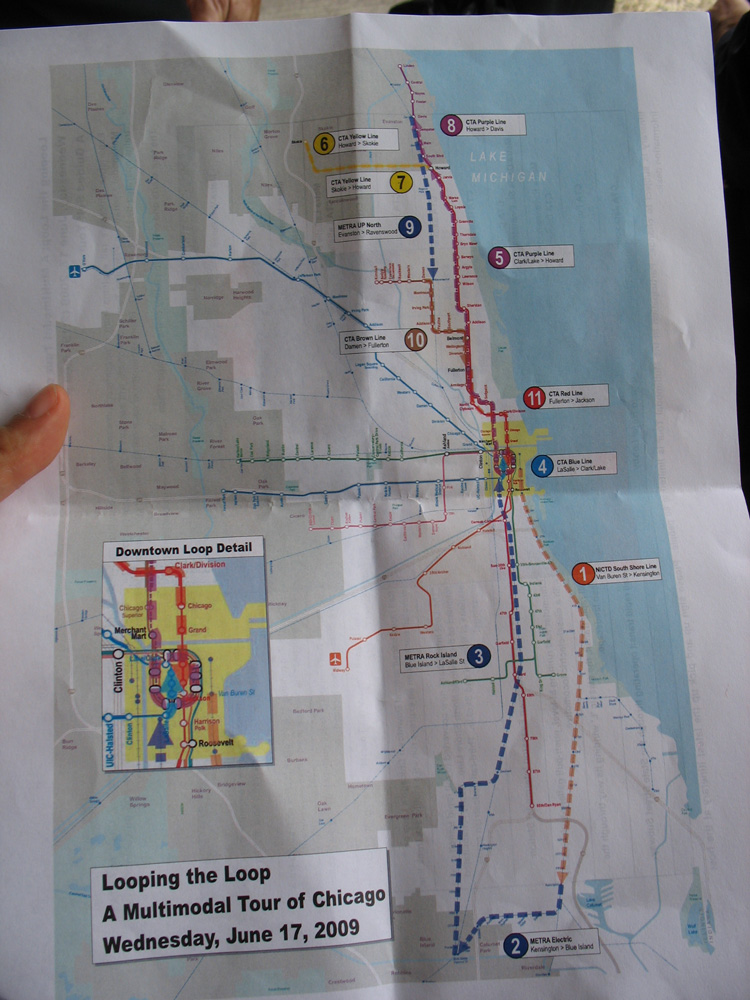
What do transportation professionals do for fun? A six-hour train trip on all the region’s rail services, around Chicago and back to our hotel again!
Tours like this have been held at the last two APTA rail conferences – they’re the brainchild of Tom Hickey, from the Houston transit authority. (You might see him in my photos: he’s wearing a hat.)
And for the past 10 years, Tom’s held these tours at APTA operations planning workshops, too. Those versions can be more intense – one tour around Oregon took two and a half days! (People drop in and out of the tour as it goes on: Tom describes the tours as a “transit death march.”)
But this tour was for lightweights — it was called Looping the Loop, and employees from all the services joined us for the trip (or parts of it). We heard system history and stories, and enjoyed a great tour of the Chicago area.
Here’s an illustrated rundown of the tour – I’ll keep it as concise as possible!
Trip 1: NICTD South Shore Line to south Chicago (Van Buren to Kensington)

The first leg of our trip started at Metra’s Van Buren Street station. We headed to south Chicago on the NICTD South Shore Line, in a commuter rail electric train.
What’s the NICTD South Shore Line? It’s a commuter rail service between Chicago and South Bend, Indiana — one of the last interurban lines in America!
NICTD uses Metra’s tracks to run the South Shore Line in Chicago (Metra is Chicago’s commuter rail system, similar to our WestCoast Express). NICTD stands for the Northern Indiana Commuter Transportation District, and the South Shore Line service dates back to the 1900s.
Here’s our NICTD train pulling into Van Buren station!
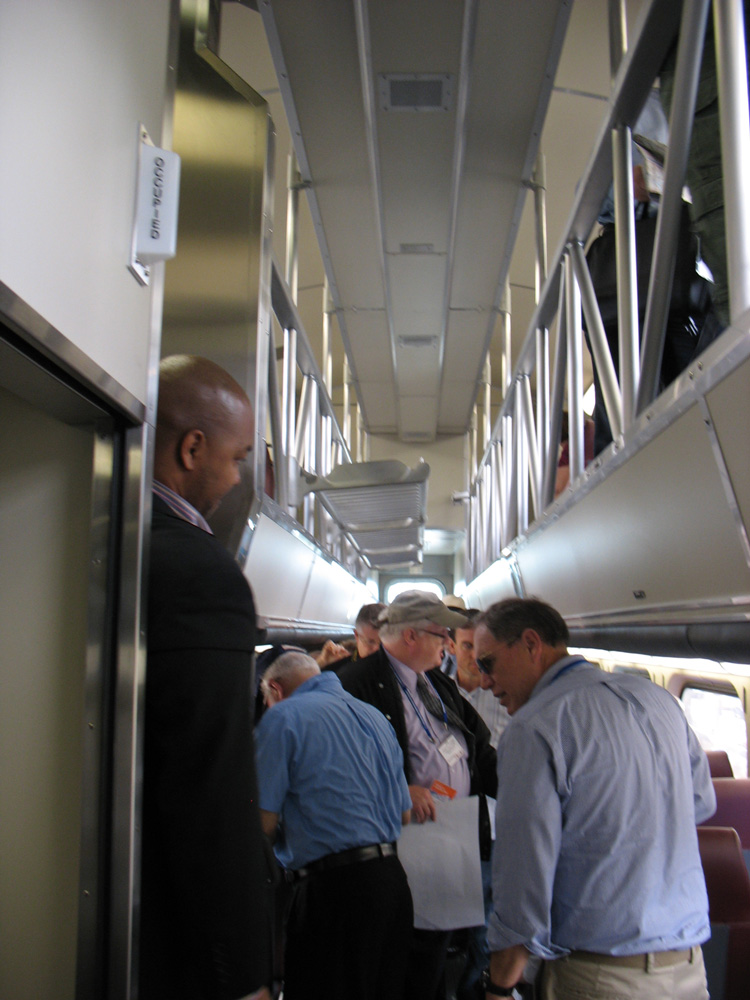
The train car has two levels – an upper deck with single seats, and a lower deck with two-seater benches.
Amazingly enough, the seat backs can change sides so you can face whichever direction you want! Check the video out to see what I mean.
The NICTD representative told us that ridership has skyrocketed on this line in the past 5 years — all of their six-car trains run at 100% capacity.
And in Michigan City, Indiana, the enormous NICTD trains actually run right into the middle of downtown!
Trip 2: Metra Electric around south Chicago (Kensington to Vermont St)
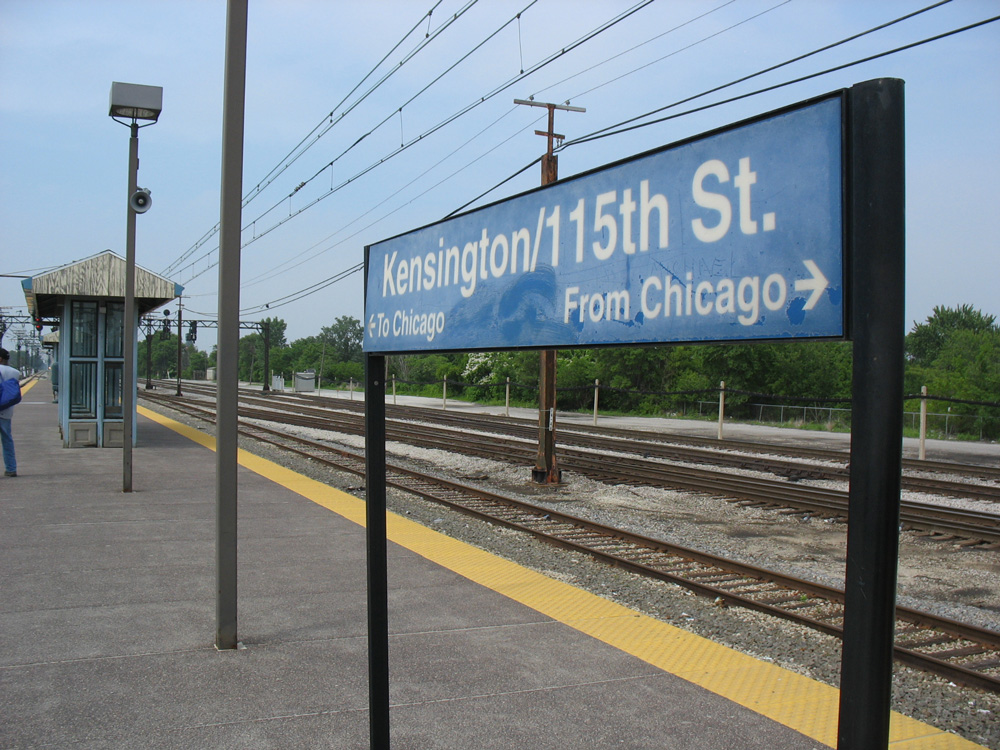
The South Shore Line dropped us off at Metra’s Kensington Station, two stops before it crossed state lines into Indiana.
There, a Metra Electric line picked us up and hauled us over to Metra’s Vermont Station, also on Chicago’s south side.
By the way, the NICTD and Metra Electric trains run on overhead wiring, just like our trolleys. The electric line was built because in 1920, the city of Chicago banned steam locomotives from running up the lakefront in downtown. The response from the rail companies was to run electric trains, which continue on today. (Stories like this really show how public transportation is shaped by choices made long ago!)
At Kensington, John Gottlieb from Metra told us a bit about the system. It’s the country’s second largest commuter rail system, with 16,000-17,000 revenue trips monthly. Their trains are 96.5% on time!
The video above shows our Metra Electric train arriving. It’s a new car, but one of the challenges Metra faces is the age of their rolling stock. Many cars date back to the 1950s, 1960s, and 1970s, and tend to break down a lot.
And check out the video above to see this train run through a suburban neighbourhood! The enormous Metra trains run very close to people’s backyards and streets, without any fencing or anything to prevent people from crossing the tracks. Given the open area, Metra does struggle with track accidents and security issues.
(Btw: the Metra train seat configuration were basically similar to NICTDs, but with different coloured seats.)
Trip 3: Metra Rock Island from south Chicago to downtown (Vermont St to LaSalle St)
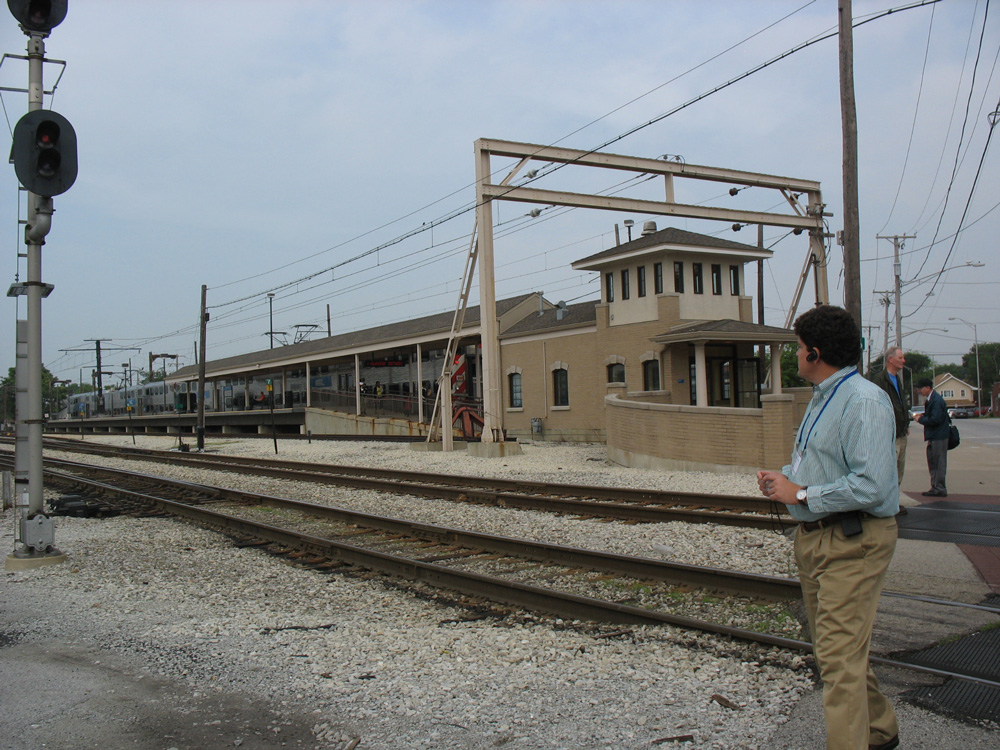
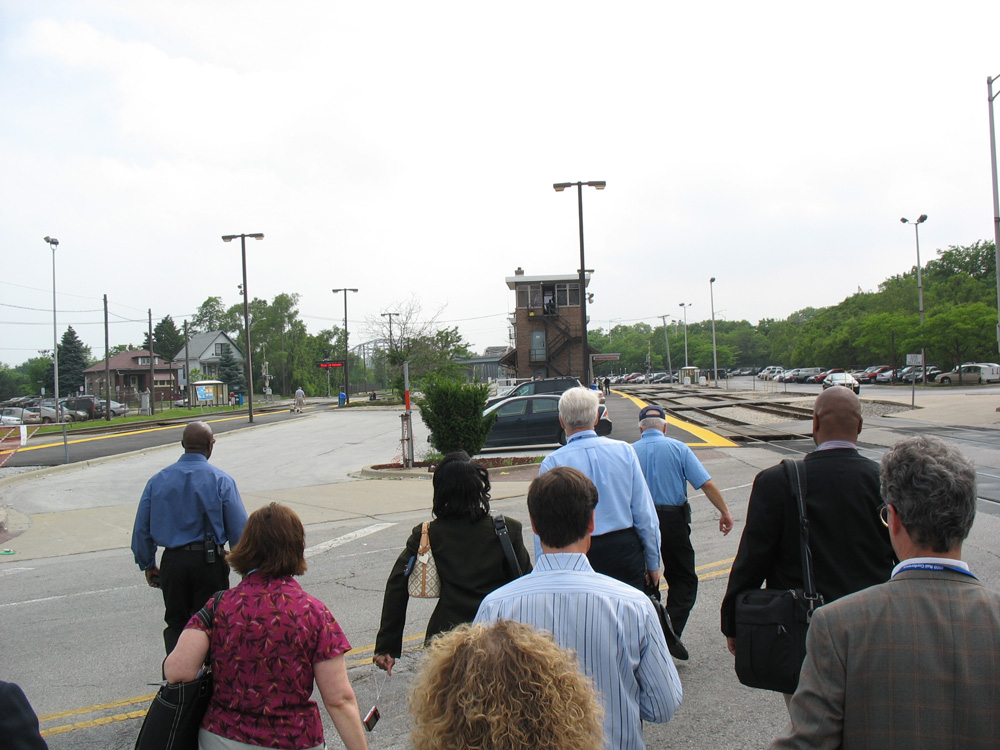
At Vermont Street/Blue Island Station, we transferred over to a diesel/electric locomotive train on Metra’s Rock Island line.
The Rock Island line was the first ever Metra service. In 1980, the Rock Island Railroad went bankrupt, and Metra’s precursor was formed by the state to run service on that line instead.
They went on acquiring lines, and now here they are today with 11 commuter rail lines and 2,800 employees.
Here’s our diesel/electric Metra train pulling into the station! It weighs 62.5 tons. Metra’s operating speed limit is 65 mph, although the trains can go faster than that.
Fun fact: 60 per cent of the trackage that existed 50 years ago in Chicago is still there today.
Another fun fact: the Blue Island Station is the only station on the south side that you can use to get to two different points in the Loop in downtown Chicago.
Trip 4: CTA Blue Line around downtown Chicago (LaSalle St to Clark/Lake)
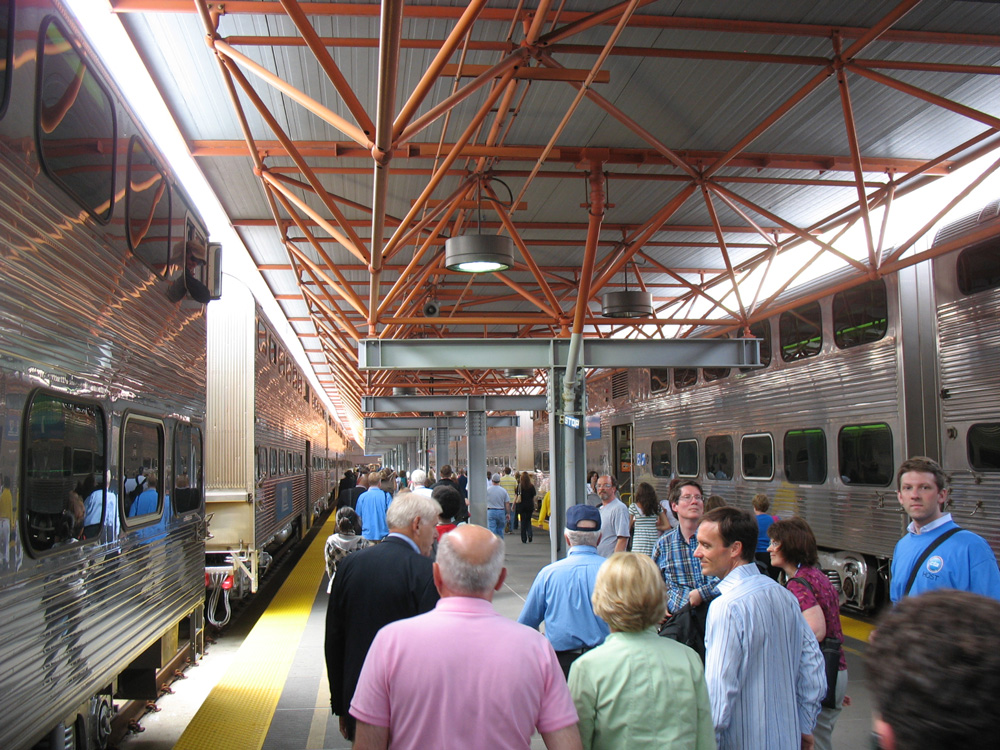
We rode back to downtown Chicago and got off in La Salle Street Station. It was just a short walk over to the Blue Line, a subway run by the Chicago Transit Authority (CTA).

Here’s the Blue Line subway station! We met several folks from the CTA here who got us on our way.

It was the rush hour period, and it turned out that the Blue Line was experiencing delays because a train had door problems.
Each Blue Line train can carry 1,000 people, so this can back things up a bit.
The next scheduled train ran through the station as an express train to clear out overcrowding. It seemed to work – the platforms stayed pretty crowd free and everybody seemed quite patient.
Bruce Moffat, a CTA employee and author of two books on Chicago transit history, joined us on our tour here, and explained that LaSalle Station was built in 1951. “It’s a middle aged station,” he said.
Here’s our subway train pulling into the station!
Trip 5: CTA Purple Line to north Chicago (Clark/Lake to Howard)
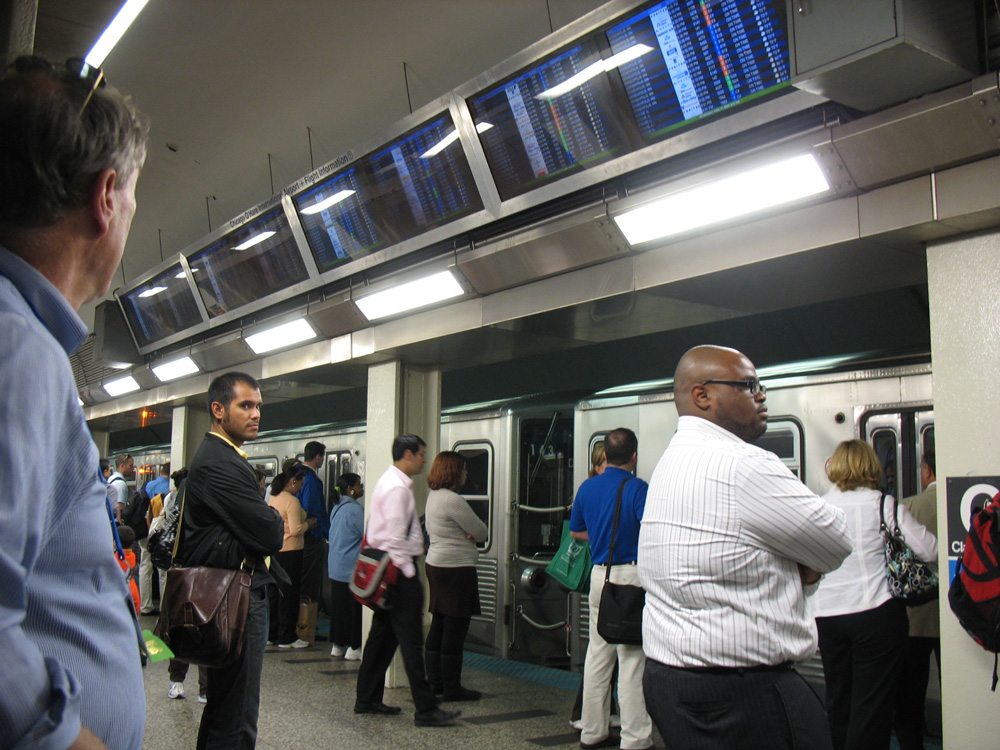
At Clark/Lake Station, we switched to the Purple Line on the CTA’s elevated train system.
The train was already there, so we hopped on and headed north toward Linden Station. Here’s a video of the view from my window!
If you don’t know about it, the elevated or “L” system does a loop over downtown Chicago, where four different train lines run. (That’s why the downtown core is called the Loop!)
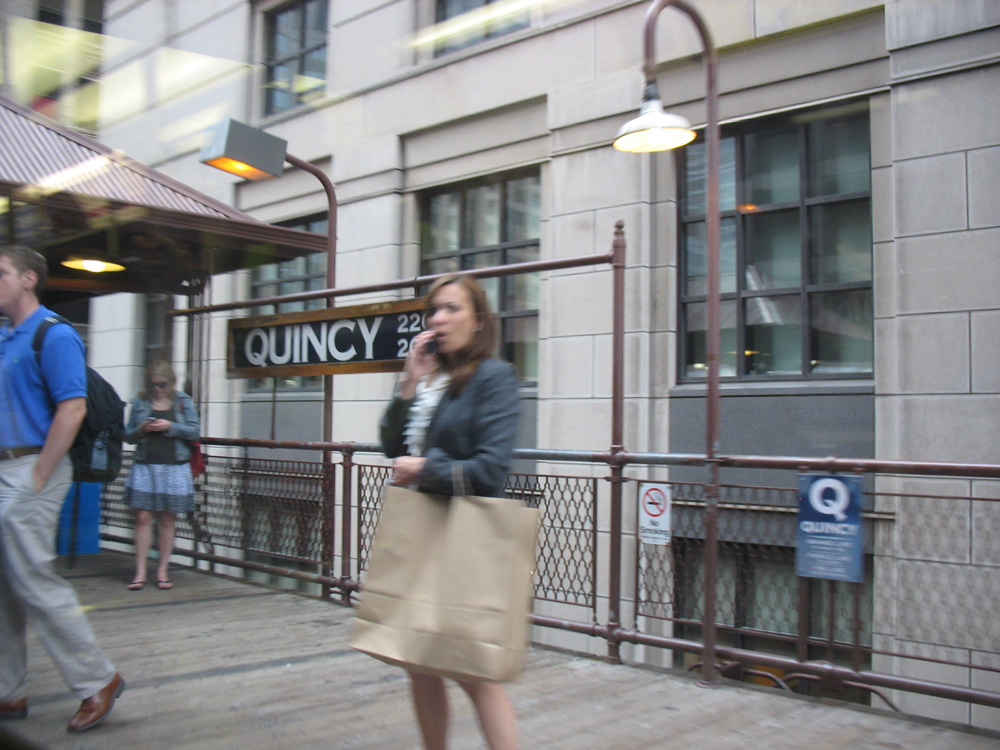
The stations and tracks are all built over the existing roadway in the late 1800s–that was done so the rail companies didn’t have to buy up land. They are a huge Chicago landmark and are still heavily used today.
Oddly enough, while four different companies originally built the elevated loop, they all built their systems to the same exact standards. In places like London, that wasn’t the case – that’s why you have to mind the gap in some stations, because the width of the station isn’t consistent along every line. Nope, mind the gap is for curved stations. But yes, London did have train stations of varying width due to no single standard for early train companies.
And by the way, the Purple Line was so named because purple is the colour of Northwestern University, where the Purple Line leads.
It’s also the CTA’s only express route – during rush hour it skips a number of stops in the downtown core and runs straight out to the northwestern suburbs.
Trip 6&7 : CTA Yellow Line from north Chicago to Skokie and back (Howard to Skokie)
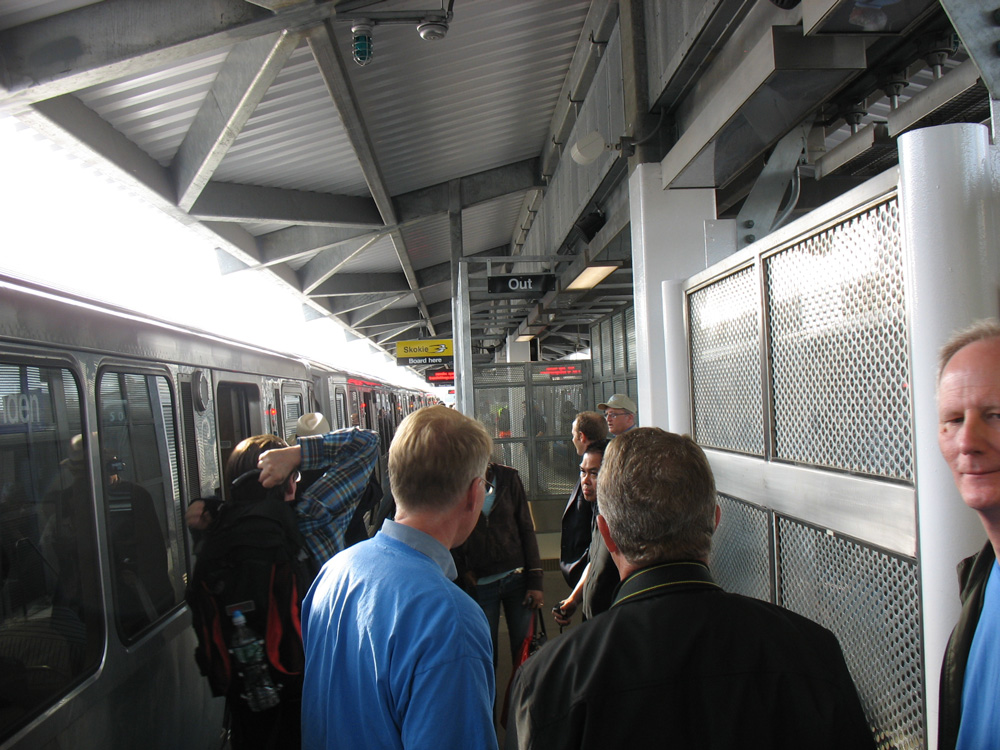
At Howard Station we transferred to the two-car Yellow Line.
The Yellow Line is basically a shuttle service from Chicago to Skokie, a very pleasant suburb of Chicago. It runs on the remnants of the historic North Shore Line, an old line that used to run from Chicago all the way to Milwaukee, Wisconsin.
Service is every fifteen minutes from about 5:45 a.m. to 11 p.m., and only recently have they introduced Sunday service. By all accounts it is quite a success.
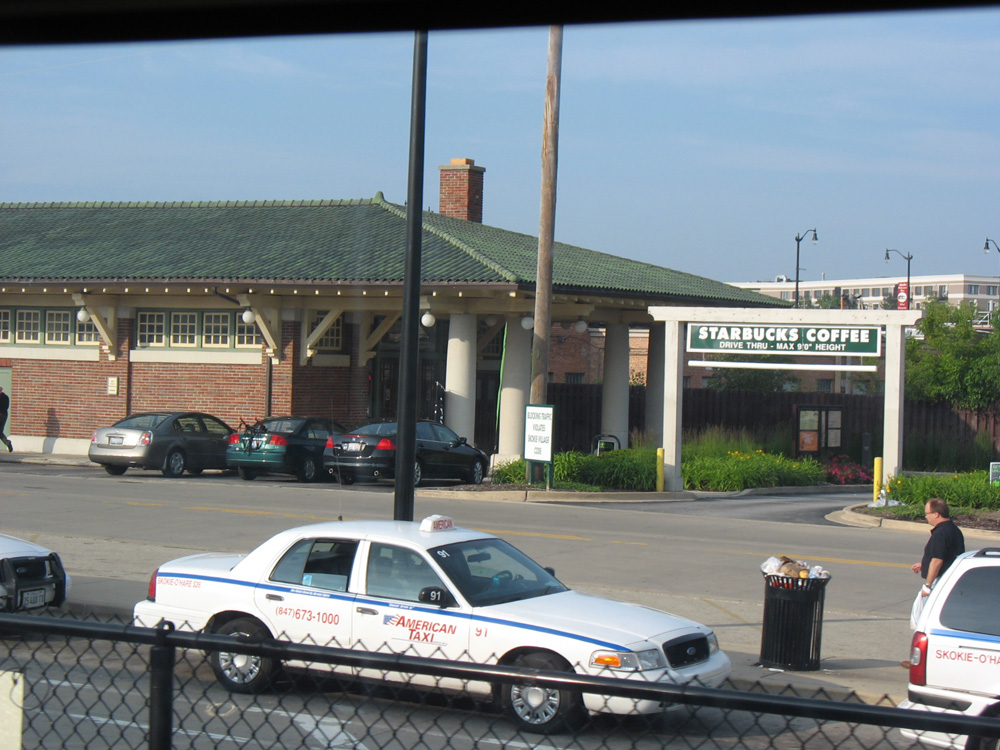
I didn’t grab any video but here’s a shot from the train when we arrived in Skokie. That Starbucks across the street is the original station house from the North Shore Line. It used to be where those taxis are: it was picked up and moved to where it is today!
We took the Yellow Line back to Howard Station after this, which counts as leg 7 of our trip. Tom says he doesn’t usually like to backtrack, but in this case it was the best option.
Trip 8: CTA Purple Line through North Chicago (Howard to Davis)

We did a little more backtracking and took the Purple Line back to Howard Station to ride south.
I should mention that Howard Station has been recently renovated and is now fully accessible and better connected to its bus loop. There’s also a large maintenance yard and train storage facility north of the station.
Trip 9: Metra Ravenswood around north Chicago (Davis to Ravenswood)
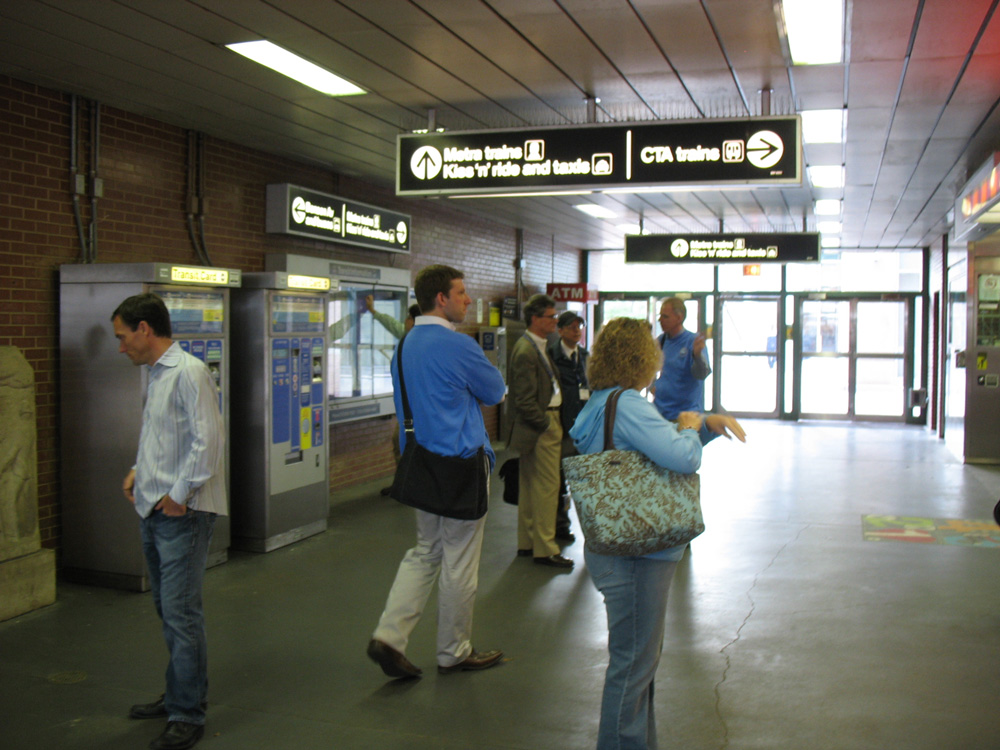
We got off at Davis Station next, in Evanston, Illinois. It was redone in the 1990s, and it’s described as a good example of a nice town centre station. There’s a pretty bus stop out front, and clock towers at both ends. Sorry, I didn’t catch photos of them!
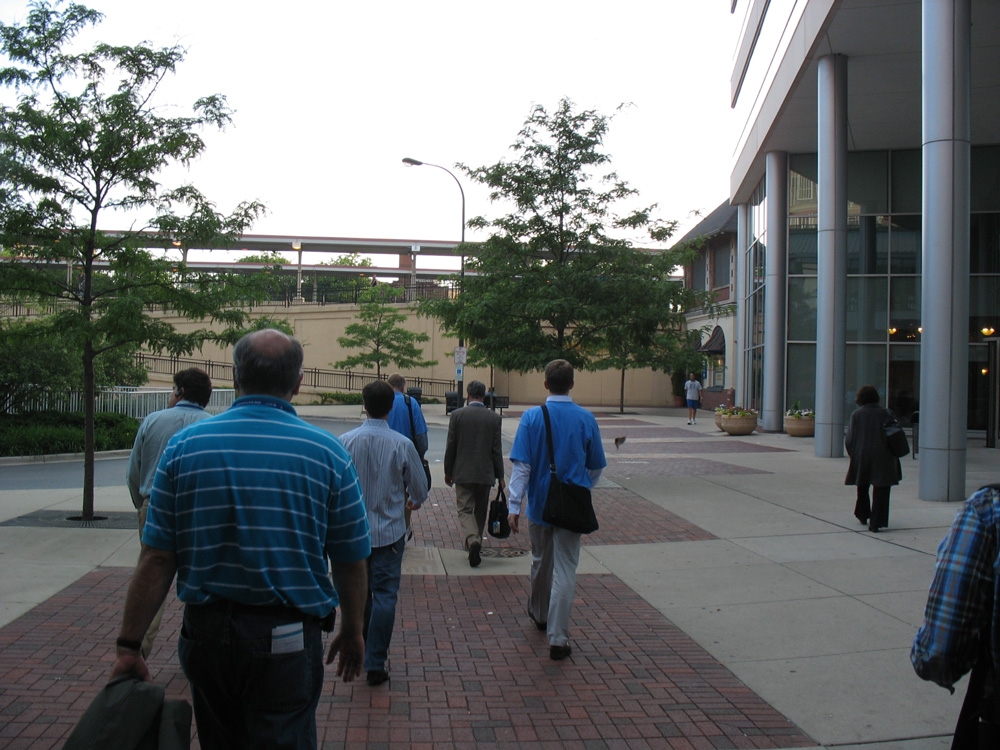
We crossed the street to the adjacent Metra station and hopped on a train on Metra’s Ravenswood line.

There was a bit of a wait here until our train arrived. We talked and learned that Evanston is a very walkable suburb of Chicago, and considered quite a nice place to live.
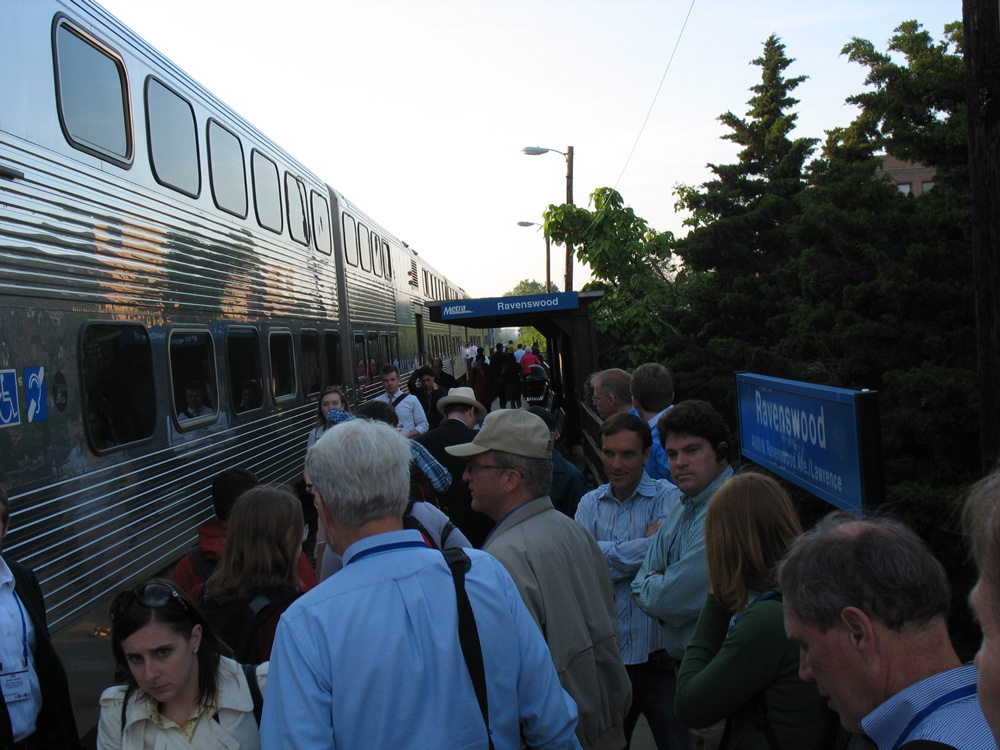
Then we got off at Ravenswood Station and then did a bit of a walk to Damen Station, on the CTA’s Brown Line. (Tom told me he had examined this part of the route via Google Earth, and asked someone at CTA to confirm it was an ok neighbourhood to walk through. It was lovely in fact!)
Trip 10: CTA Brown Line through north Chicago (Damen to Fullerton)
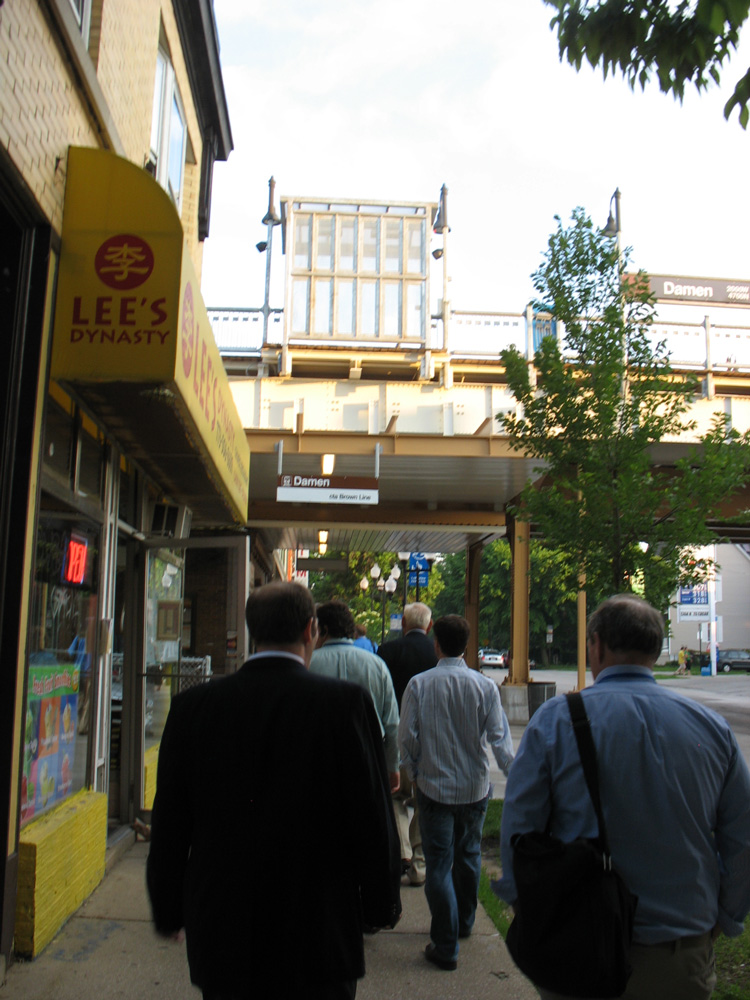
I’ll skip all the walking to get to the station here. Damen has recently been refurbished, and has added fare gates and a more modern entry way.
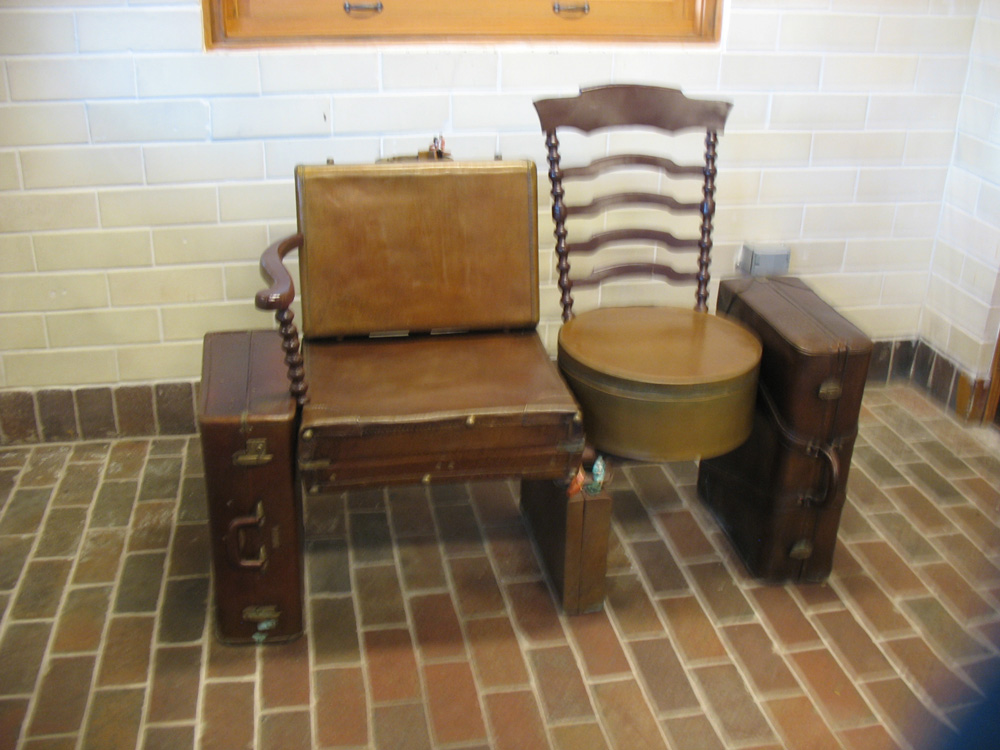
They still have their old station house in front though, and here’s a picture of the super cute metal furniture they have in there!

Then it was back up to the elevated platform to catch the Brown Line.
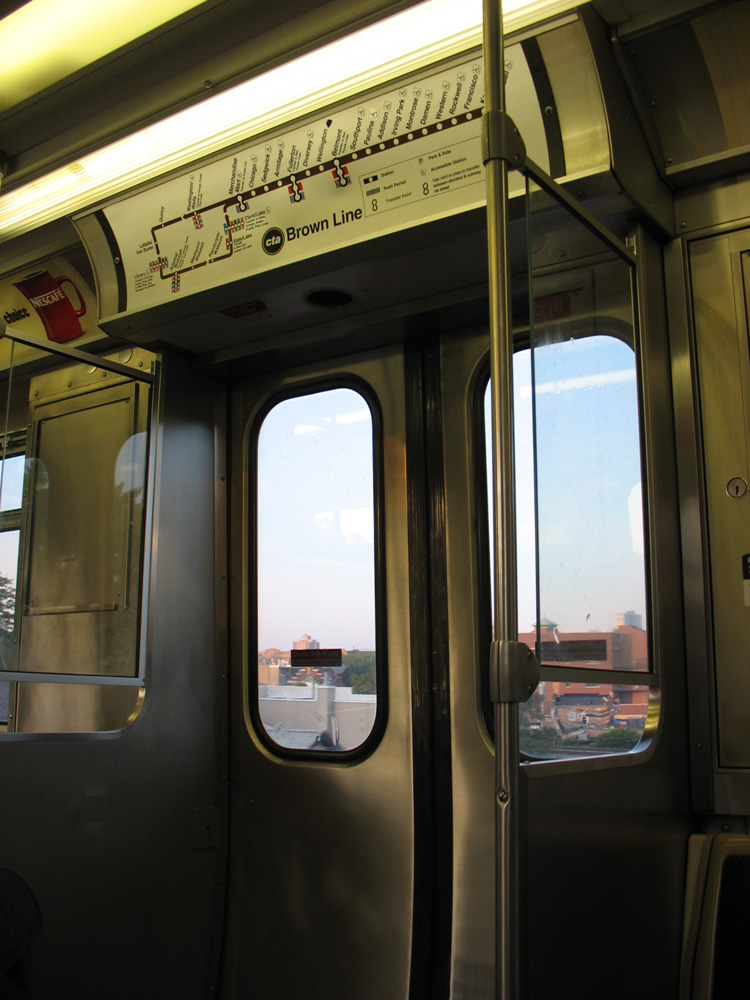
Trip 11: CTA Red Line to downtown Chicago (Fullerton to Harrison)
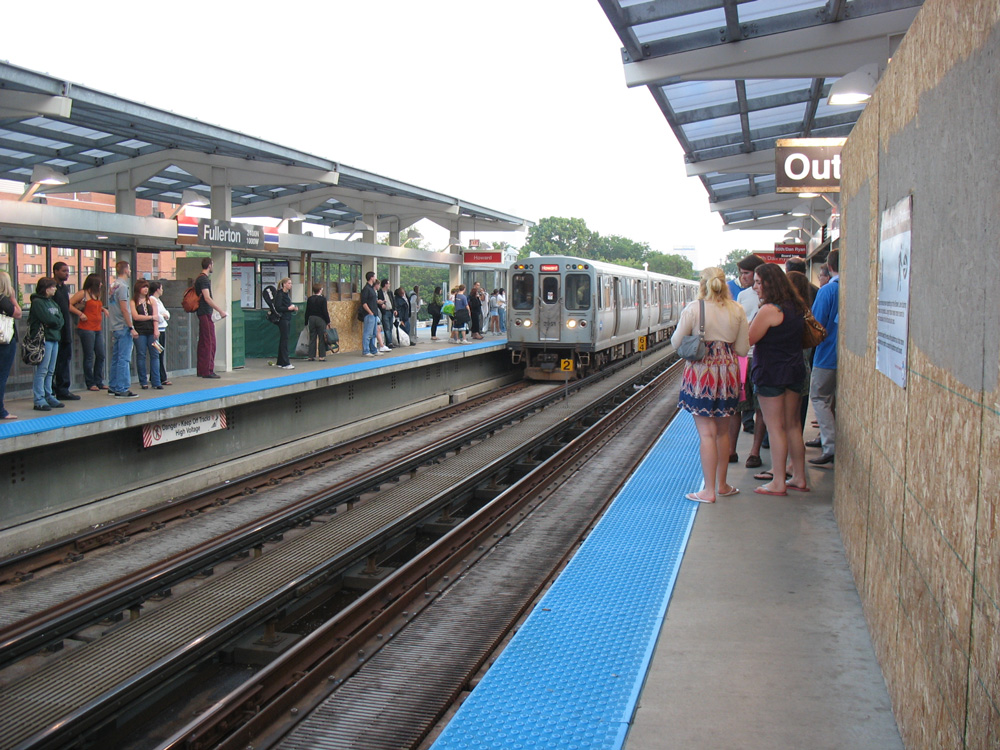
And finally we hit the last leg of our trip! Boy, you can tell I’m running out of steam – there’s hardly any photos left. This is Fullerton Station where we got on the Red Line to head back to our start point.
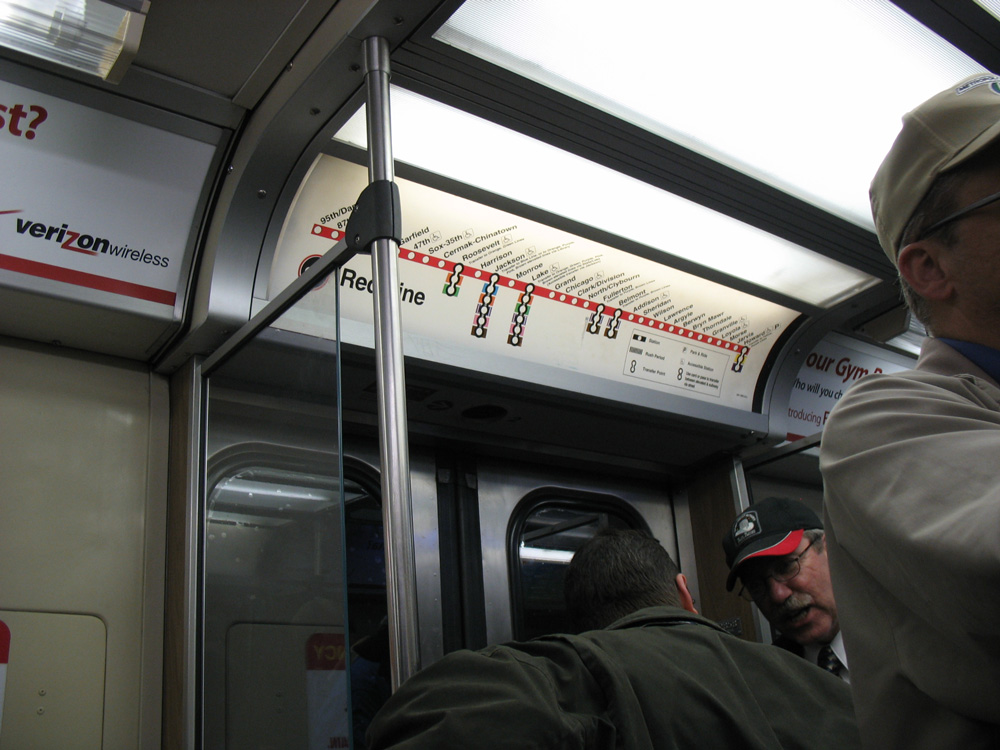
The Red Line is the other CTA subway under downtown Chicago (it’s elevated outside the downtown core).
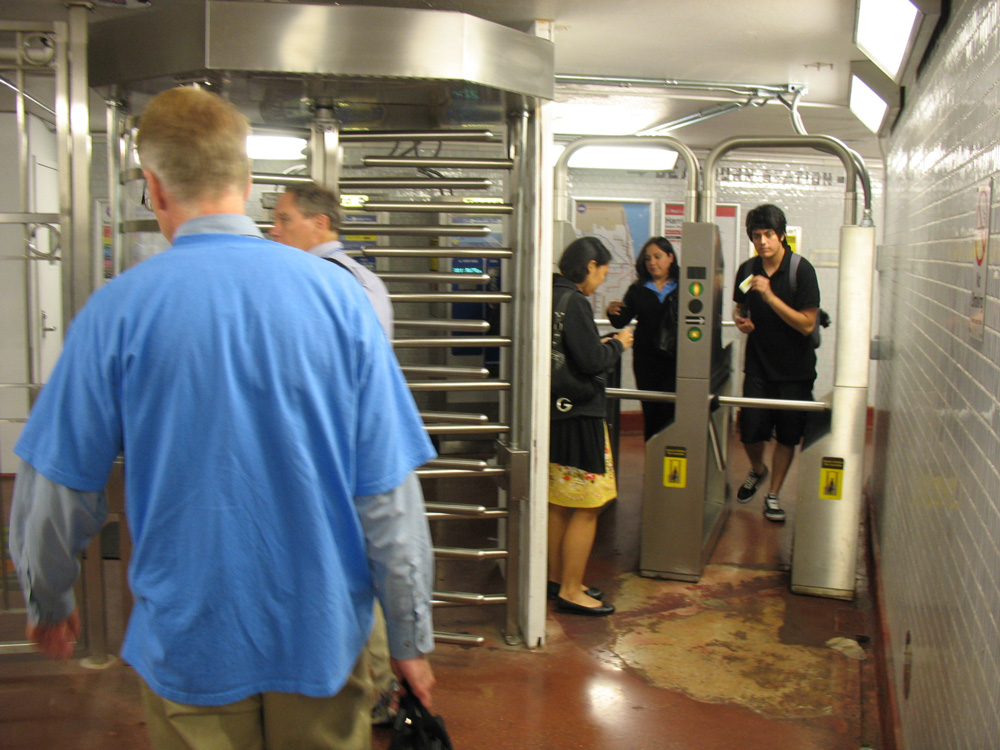
Finally, we landed back at Harrison Station, which I visited in my first post about Chicago transit.
I did wind up learning a bit more about Harrison Station btw. This is the auxiliary entrance to Harrison, which is currently functioning as the only station entrance, since the escalator is being repaired at the main entryway.
The auxiliary entrance hadn’t been used in more than 50 years – they refurbished it six months ago so they could use it! There’s apparently still signage pointing to Dearborn Station in it, which was long ago closed.
And thus ends our tour of Chicago rail transit… I hope you enjoyed it as much as I did!






Jhenifer,
I don’t beleive you are right about London’s Mind the Gap. Mind the Gap is used where stations are built on a sharp curve, causing a gap between the platform edge and the door.
you are correct the lines were not built to a standard. The Subsurface lines were built to 7ft “broad-gauge” standard, then converted to standard gauge later. The deep tubes were built to two different diametres – the smaller diameter were enlarge in the 1920s to the tube deep-level “standard”.
At some stations where deep-level tube trains share the platform with the sub-surface trains, the platform height is a special high to allow passenger to step up from a tube train and down from a sub-surface train.
OK, I’ll amend it. But now you have to tell me if you like Chicago’s trains.
Did you see any of that “SideTrack” advertisement I was asking about?
After watching the videos, I started to notice the people with solid coloured shirts. Are those the conference participants or are they the transit staff uniforms?
Are all transit vehicles air conditioned? How does Chicago transit change when snow comes?
You know, I looked but didn’t see the SideTrack ads you talked about. Perhaps they’re further out in the subway tunnels — I was just moving around the downtown area really.
The people in the solid coloured shirts are our CTA tour guides. The CTA employees on the system usually wear emergency vests in neon yellow/orange with “CTA” on them. CTA’s company colour is that light blue though — and in fact, the blue rumble strips on their platform are done because that’s the CTA colour. They’re one of the few systems in North America that doesn’t have yellow or white rumble strips.
All CTA trains are air conditioned and I think most of the buses are too. Not sure about how the snow impacts service… I never asked!
I recently traveled to Chicago at the end of May and the pictures you posted reminded me of my trip there. Some things I really liked about the Chicago Transit are that both the Red and Blue train lines run 24 hours a day (half hour service between 2am-5am). I also really liked how they offer tourist passes in 1, 3, and 5 day passes (I bought a 3 day pass for only $14).
Pardon the necromancy, but as a Chicagoan, I have to point out two things:
1) The trains you rode on the South Shore Line aren’t typical South Shore Line trains – they are just the newer ones. Most of the time, NICTD runs the older single-level trains with more doors and bigger luggage racks
2) The line you called “Ravenswood Line” is actually Union Pacific North Line – Ravenswood Line is Brown Line’s original name.
Other than that, awesome post. Sounds like you and the rest of the group had a very interesting trip.
Strannik: thanks for the clarifications!
[…] This multimodal tour is lovingly crafted by Tom Hickey, associate vice-president at the Houston transit authority and longtime transit planner. He’s done tours like this for the past three years at APTA’s rail conferences: last year, we did a six-hour train tour in Chicago! […]
top Shopping cheap christian louboutin nike dunk mid Cheap Polo Shirts nike dunk
[…] The Buzzer blog » Buzzer in Chicago: Six hours, 10 trains, 11 18 Jun 2009. NICTD uses Metra's tracks to run the South Shore Line in Chicago (Metra is. Each Blue Line train can carry 1000 people, so this can back. – The Buzzer blog » Buzzer in Chicago: Six hours, 10 trains, 11 […]